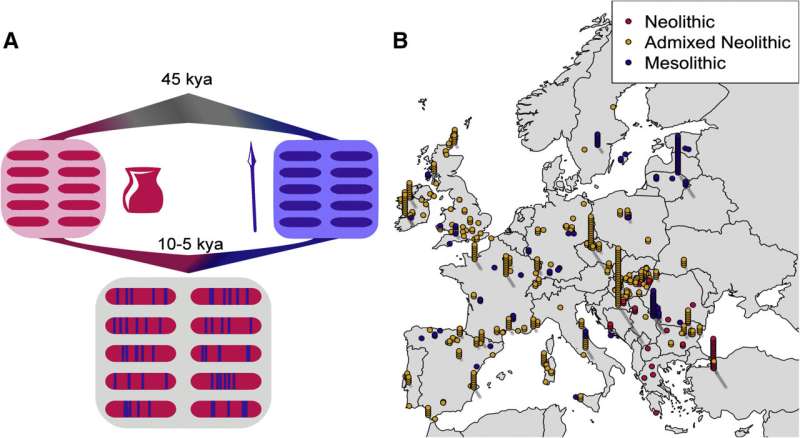Admixture model and geographic distribution of Neolithic and Mesolithic individuals with genome-wide ancient DNA. (A) An illustration of the genetic history of the Neolithic-Mesolithic transition in Western Eurasia. (B) “Casino-plot” of individuals included for analyses, colored by the ancestry group for which those individuals were used in this paper. For sites with multiple samples, we stack those individuals above the reported coordinates. Credit: Current Biology (2023). DOI: 10.1016/j.cub.2023.02.049
Research from the Francis Crick Institute published today in Current Biology has revealed that diversity in genes coding for immunity may have facilitated adaptation to farming lifestyles in prehistoric periods.
Researchers at the Ancient Genomics Laboratory at the Crick studied available genome-wide DNA from 677 individuals dating to Stone Age Europe, spanning the movement of Neolithic farmers from the Near East into Europe about 8,000 years ago, where they mixed with Mesolithic hunter-gatherers already in Europe.
They were interested in whether any particular genes might have coded for adaptations important to early farming groups, and looked for evidence of rapid evolution in these populations.
Since about 20% of the ancestry of descendant late Stone Age people could be traced to the local European hunter-gatherers, the researchers also asked whether any particular genes showed evidence of more hunter-gatherer ancestry.
They found that a large genetic region responsible for immune responses to diseases—the major histocompatibility complex (MHC)—showed both the strongest evidence of rapid evolution, and more Mesolithic hunter-gatherer ancestry than expected, suggesting that genetic variants in the MHC region already present in Europe were passed down preferentially.
It has previously been thought that the transition to farming was associated with increased natural selection on immunity variants, as people started living closer to animals and eating more animal products. This research supports this view, but also shows that diversity in immune genes may be just as important as adaptation to lifestyle.
The research team speculates that either the hunter-gatherers already had genetic adaptations against bacteria, viruses or other microorganisms in Europe, or that having many different forms of the genes was advantageous.
Tom Davy, Ph.D. student at the Francis Crick Institute and lead author, said, "It was really exciting to see for the first time that immunity is important for the transition to farming in a prehistoric population. The later Neolithic people had far more farmer ancestry in general, so we expected to see the same at the MHC region, especially as many diseases have been linked to Neolithic periods. But we saw about 50:50 ancestry from Neolithic farmers and Mesolithic hunter-gatherers here, showing that natural selection favored genes from the hunter-gatherers already in Europe.
"At the moment we're not quite sure why this happened, but a proposal is that the European hunter-gatherers had genetic variations which allowed them to fight Europe-specific diseases. Or picking up a variety of genes from both hunter-gatherers and farmers was beneficial because it resulted in lots of diversity at this major group of genes, allowing people to better fight off disease."
The team also confirmed results from previous studies, showing that genes coding for skin pigmentation showed the greatest representation for Neolithic farmer ancestry, with these variations coming into Europe from the Near East. This may be to maintain vitamin D levels when sources, such as diet and exposure to sunlight, change.
Pontus Skoglund, Group Leader of the Ancient Genomics Laboratory at the Crick, said, "The shift to farming was an important transition all over the world, resulting in changing diets and exposure to infectious disease.
"Previous research has suggested that adaptation in genetic regions relating to immunity, such as the MHC, has been important in recent time periods, and this research now provides similar evidence for adaptation in prehistory. By growing the ancient genomic record, we will be able to better understand the role of immunity in other periods of the human past."
More information: Pontus Skoglund, Hunter-gatherer admixture facilitated natural selection in Neolithic European farmers, Current Biology (2023). DOI: 10.1016/j.cub.2023.02.049. www.cell.com/current-biology/f … 0960-9822(23)00189-6
Journal information: Current Biology
Provided by The Francis Crick Institute
























